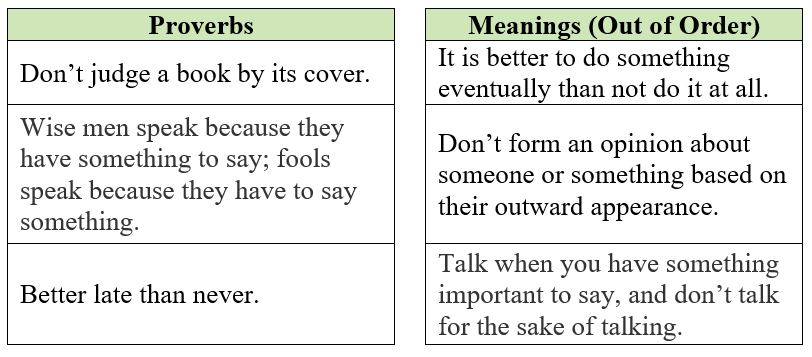4 Activities to Incorporate Students' Culture in English Language Classrooms
by Andrew J. Wykretowicz

In this globalised world, our English as a second language
(ESL) classrooms are more diverse than ever before. Our goal is to teach our
multilingual language learners English, but we also have an opportunity to
learn about our students and learn from them about their cultures. This
approach can help eradicate stereotypes and misconceptions and create a
student-centric environment. As a result, everyone feels welcomed and
appreciated.
The following set of activities provides one way to
teach English while incorporating various cultures. These activities allow
students to share their heritage language and culture and at the same time
improve their English. Each of the activities can be modified based on class
size and English proficiency levels.
1. Loanwords
This is an easy early program exercise which
demonstrates that students may already know some English words without
realizing it. Most languages borrow words from other languages, and English is
not an exception. These borrowed words are called loanwords.
For this activity, study the linguistic background
of your students to find any loanwords from their home languages. Write these
words on small cards and place them face up on a table, then ask the students
to come over and pick the cards with words they know. After the students are
finished, have them present the words, and you write them on the board. When
all students have presented their words, share the original language of the
words and explain that those words are also English words borrowed from other
languages. Following is a sampling of words I have used with my
students:
- lasagna, spaghetti, cappuccino, pizza
(Italian)
- kielbasa, pierogi, kasha, babka, mazurka
(Polish)
- kindergarten, brat, wurst, lager (German)
- salsa, taco, siesta, burrito, enchilada (Spanish)
- babushka, gulag, perestroika (Russian)
- baklava, kiosk, shish kebab (Turkish)
- chutney, guru, khaki, karma (Hindi/Urdu)
- dim sum, ketchup, monsoon (Chinese)
- sushi, sumo, bonsai, ikebana, anime
(Japanese)
In this example, you could ask students if they
notice any patterns or similarities in the words. (Many of these are words for
food!) For more advanced classes, you can ask students to say the word aloud
and write it on the board. This activity offers great encouragement for
students to expand their English vocabulary while connecting to their own and
their classmates’ cultures.
2. Cultural “If…” Clauses
This exercise is for intermediate to advanced
students. Students get a chance to practice if… clauses,
share some features of their home countries or cities, and learn some cultural
aspects of their classmates’ as well.
Model for students by writing examples on the board
using your own home city, and read aloud your model sentences.
Examples
- If you visit Chicago, you will see Willis (Sears)
Tower.
- If you go to Chicago Millennium Park, you will
see the Bean.
Next, distribute index cards and ask student to
write sentences using the if… clause to describe something
about their home town. When everyone is done, students share their work.
Examples
- If you visit Tokyo in spring, you will see cherry
blossoms.
- If you go to London, you will see the Big
Ben.
Examples are often quite interesting to students
and prompt further questions, leading to lively discussion. Where possible, you
should highlight conditional clauses during class discussion.
Optional Activity:
Present the sentences with incorrect information and ask students to correct
them.
Examples
- If you visit Berlin, you will see the
Coliseum.
- You will see Taj Mahal, if you go to
Bangkok.
Modification: For more
practice, the activity can be repeated with the use of proverbs or quotes
instead of places to visit.
Examples
- If you have a garden and a library, you’ll have
everything.
- If you scratch my back, I’ll scratch
yours.
3. Finding Meaning in Proverbs
There are a number of proverbs which seem to be
universal, and even if a specific well-known proverb is not known in a
particular culture, there is often a proverb within that culture with a similar
meaning.
For this activity, hand out a sheet containing
explanations/meaning to well-known proverbs. Read one aloud or write it on the
board, and ask your students to assign a correct meaning from their
sheet.

Figure 1. Example proverbs and meanings.
After proverbs and meanings have been matched up,
ask students if they’re familiar with these proverbs in their home languages,
or if there is something said that is similar. You can also ask them if there
are any well-known proverbs from their home cultures that they’d like to share.
4. Outlining Family Structure
Another easy exercise that allows students to share
their customs is outlining family structure. Various cultures have different
definitions of what constitutes a family. The aim of this activity is to build
vocabulary related to family. Start with the following chart and ask students
to complete it to reflect their family structure:

Figure 2. Family structure chart.
This activity is great for leading into a
discussion about the meaning of the word family in
different cultures, as well as other family-related traditions, like passing on
names.
Conclusion
These are just a few activities to
incorporate your students’ cultures into your English language classrooms, for
both their benefit and your own. With a little creativity, you can use these as
a springboard for further cultural activities and rich classroom interaction
and discussion.
Andrew J.
Wykretowicz (MA TESOL) is an experienced
EFL/ESL instructor. He is an adjunct in the College of DuPage ESL program and
also teaches at nonprofit organizations in Chicago, Illinois, USA. He
previously taught ESL at Oakton Community College in Skokie, Illinois; colleges
in New York City; a private school in Connecticut; the Refugee Resettlement
Office in Virginia; and at organizations in Canada and Poland. He is also an
active member of ITBE
and TESOL International Association.
TESOL Blogs
Interested in writing a blog for TESOL?
Read the submission guidelines and send us your post!
Check out some of the most recent TESOL Blogs:
|
10 Asset-Based Approaches to Professional Development, by Laura Baecher

I have been teaching for over 15 years now and I have rarely come across professional development programs in my country that make the teachers’ assets visible…Professional learning [should] follow the same learning rules that apply to our learners. Teachers are lifelong learners. Therefore, to help them continue developing professionally, professional development training organizers should build on teachers’ assets. (Hadizatou Amou Ali, Niger)
In their work with students, teachers globally are working to shift from deficit-based to more equity-focused, asset-based approaches, and they deserve the same treatment in the professional development (PD) they participate in. How can those who design and lead PD for teachers create asset-based programming to draw on teachers’ strengths, experiences, talents, and knowledge? This month’s TESOL Professional Development Blog is coauthored by Julie Kasper, Director of Teacher Learning and Leadership at the Center for Professional Learning at Childhood Education International, and her colleagues in Lebanon, Niger, and Kenya who weigh in on how they have experienced and envision asset-based teacher PD. Read more. |
|
Reading Barefoot, by Spencer Salas

Happy winter holidays from the University of North Carolina at Charlotte! Last month, I wrote about literacies of vulnerability and how my fourth grade teacher, Mrs. Dahlstrom, cried when she turned to the final page of Where the Red Fern Grows. Before that, we looked at intergenerational literacies, how “reading with purpose” shapes what and how we read, and the funds of knowledge we tap into to do so.
For this post, I’m writing off another childhood memory. It’s about reading barefoot as a second-grader at Kainalu Elementary School in Kailua, Hawaii. It goes like this: Read more. |
|
Intersections of Race, Language, and Education: 8 Interviews With Scholars to Put in Your Ears, by Naashia Mohamed

We live in a time when we can find a podcast on every possible conceivable topic. It’s an engaging way of tuning into some professional learning and reflection while we go about our everyday lives. Though there is a vast range of podcasts out there, I personally enjoy listening to interviews with scholars whose work I engage with primarily through books and journal articles. When I share podcast interviews in my teacher education courses, several of my students have responded by saying how hearing educators and researchers talk about the work they do in the more informal setting of a podcast makes it easier to understand and relate to their ideas.
In this blog, I’d like to share eight podcast interviews that intersect race, language, and education. Go ahead and have a listen. Read more. |